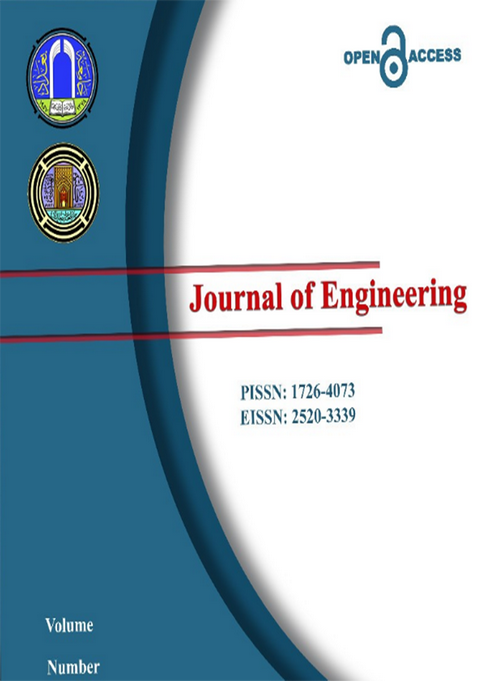Abstract
The present work aimed to study the efficiency of nanofiltration (NF) and reverse
osmosis (RO) process for water recovery from electroplating wastewater and study the factors
affecting the performance of two membrane processes. Nanofiltration and reverse osmosis
membranes are made from polyamide as spiral wound module. The inorganic materials ZnCl2,
CuCl2.2H2O, NiCl2.6H2O and CrCl3.6H2O were used as feed solutions. The operating parameters
studied were: operating time, feed concentrations for heavy metal ions, operating pressure, feed
flow rate, feed temperature and feed pH. The experimental results showed, the permeate
concentration increased and water flux decreased with increase in time from 0 to 70 min. The
permeate concentrations increased and flux decreased with increase in feed concentrations from
10 to 300 mg/l. Raising of pressure from 1 to 4 bar, permeate concentration decreased for RO,
for NF decreased and then increased at high pressure and increase the flux. The rises of flow rate
from 20 to 50 l/h decreased permeate concentration and the flux increase. The rises of
temperature from 26 to 40 °C, increased permeate concentration and increased the flux. The rise
in pH from 4 to 7, decreased the flux as the pH goes from acidic side towards alkaline. The
polyamide nanofiltration membrane had allowed permeation of chromium and copper ions to
lower than permissible limits. Nanofiltration membrane had allowed permeation of nickel and
zinc ions at low concentration of these ions. The polyamide RO membrane gave a high
efficiency for removal of chromium, copper, nickel and zinc and it had allowed permeation of
these ions to the lower than permissible limits. The rejection at first three minutes when the feed
concentration approximately was constant for chromium in NF and RO, was 99.7% and 99.93%,
for copper was 98.43% and 99.33%, for zinc was 97.96% and 99.49%, and for nickel was
97.18% and 99.49% respectively. The maximum recovery for chromium in NF and RO was
71.75% and 48.5%, for copper was 75.62% and 50.68%, for zinc was 80.87% and 54.56%, for
nickel was 60.06% and 46.18% respectively. For a mixture of synthetic electroplating
wastewater, nanofiltration and reverse osmosis membranes have a high rejection percentage for
heavy metal ions. It was obtained pure water and concentrations of less than allowable limits for
heavy metals in the case of the mixture.
osmosis (RO) process for water recovery from electroplating wastewater and study the factors
affecting the performance of two membrane processes. Nanofiltration and reverse osmosis
membranes are made from polyamide as spiral wound module. The inorganic materials ZnCl2,
CuCl2.2H2O, NiCl2.6H2O and CrCl3.6H2O were used as feed solutions. The operating parameters
studied were: operating time, feed concentrations for heavy metal ions, operating pressure, feed
flow rate, feed temperature and feed pH. The experimental results showed, the permeate
concentration increased and water flux decreased with increase in time from 0 to 70 min. The
permeate concentrations increased and flux decreased with increase in feed concentrations from
10 to 300 mg/l. Raising of pressure from 1 to 4 bar, permeate concentration decreased for RO,
for NF decreased and then increased at high pressure and increase the flux. The rises of flow rate
from 20 to 50 l/h decreased permeate concentration and the flux increase. The rises of
temperature from 26 to 40 °C, increased permeate concentration and increased the flux. The rise
in pH from 4 to 7, decreased the flux as the pH goes from acidic side towards alkaline. The
polyamide nanofiltration membrane had allowed permeation of chromium and copper ions to
lower than permissible limits. Nanofiltration membrane had allowed permeation of nickel and
zinc ions at low concentration of these ions. The polyamide RO membrane gave a high
efficiency for removal of chromium, copper, nickel and zinc and it had allowed permeation of
these ions to the lower than permissible limits. The rejection at first three minutes when the feed
concentration approximately was constant for chromium in NF and RO, was 99.7% and 99.93%,
for copper was 98.43% and 99.33%, for zinc was 97.96% and 99.49%, and for nickel was
97.18% and 99.49% respectively. The maximum recovery for chromium in NF and RO was
71.75% and 48.5%, for copper was 75.62% and 50.68%, for zinc was 80.87% and 54.56%, for
nickel was 60.06% and 46.18% respectively. For a mixture of synthetic electroplating
wastewater, nanofiltration and reverse osmosis membranes have a high rejection percentage for
heavy metal ions. It was obtained pure water and concentrations of less than allowable limits for
heavy metals in the case of the mixture.
Keywords
electroplating wastewater.
nanofiltration
Reverse Osmosis
